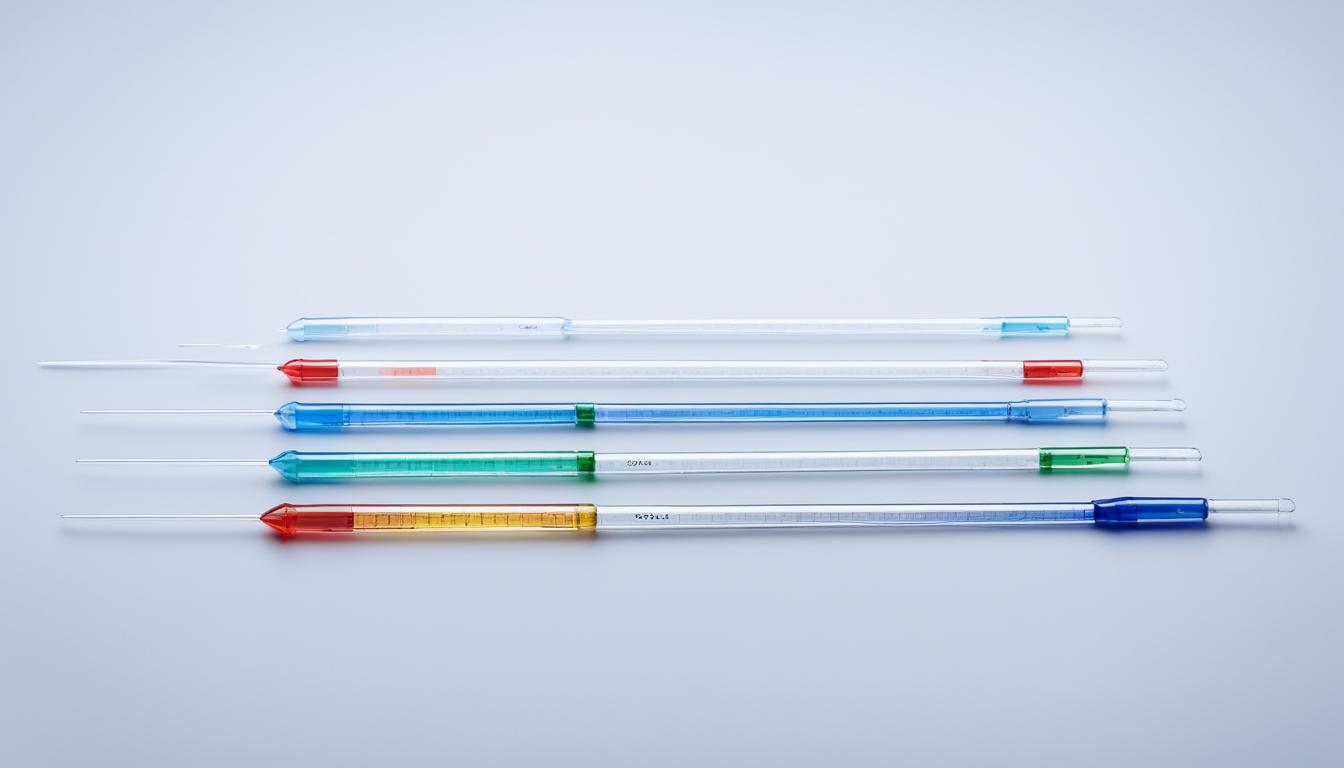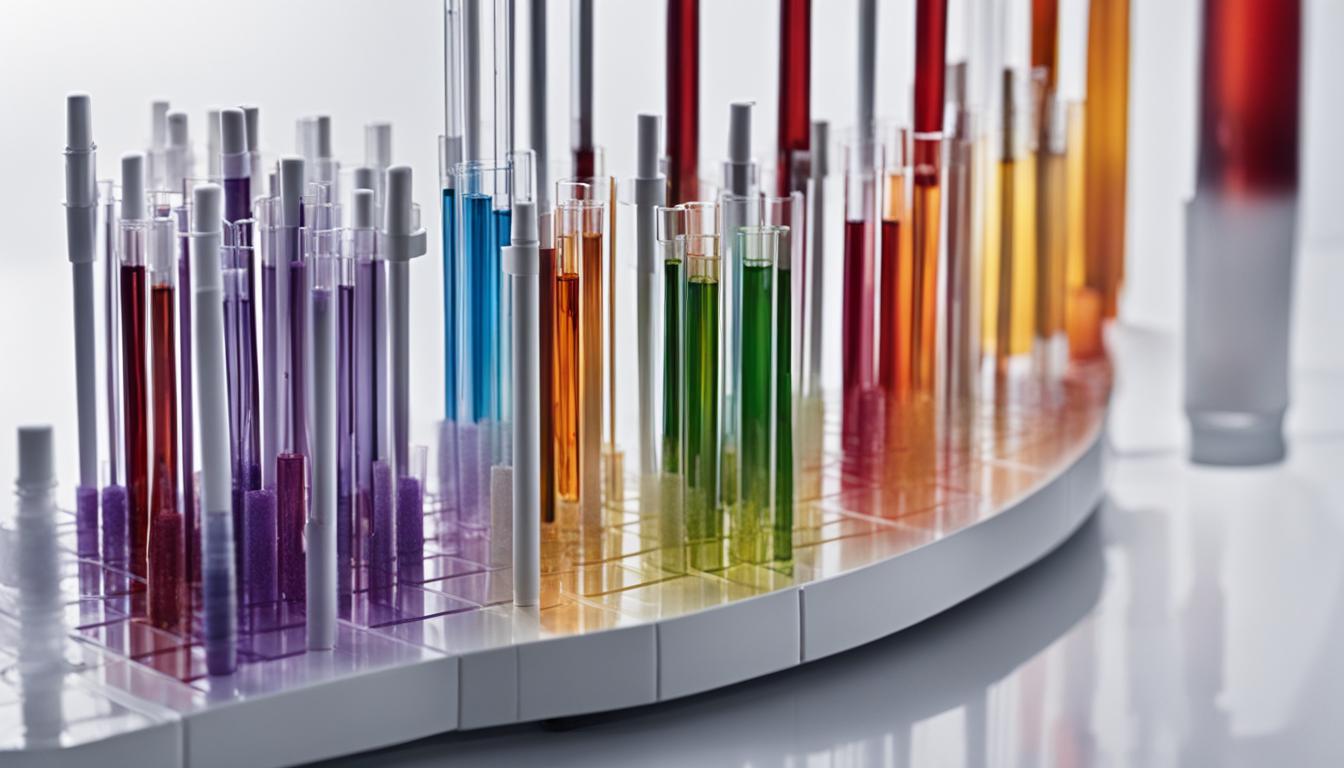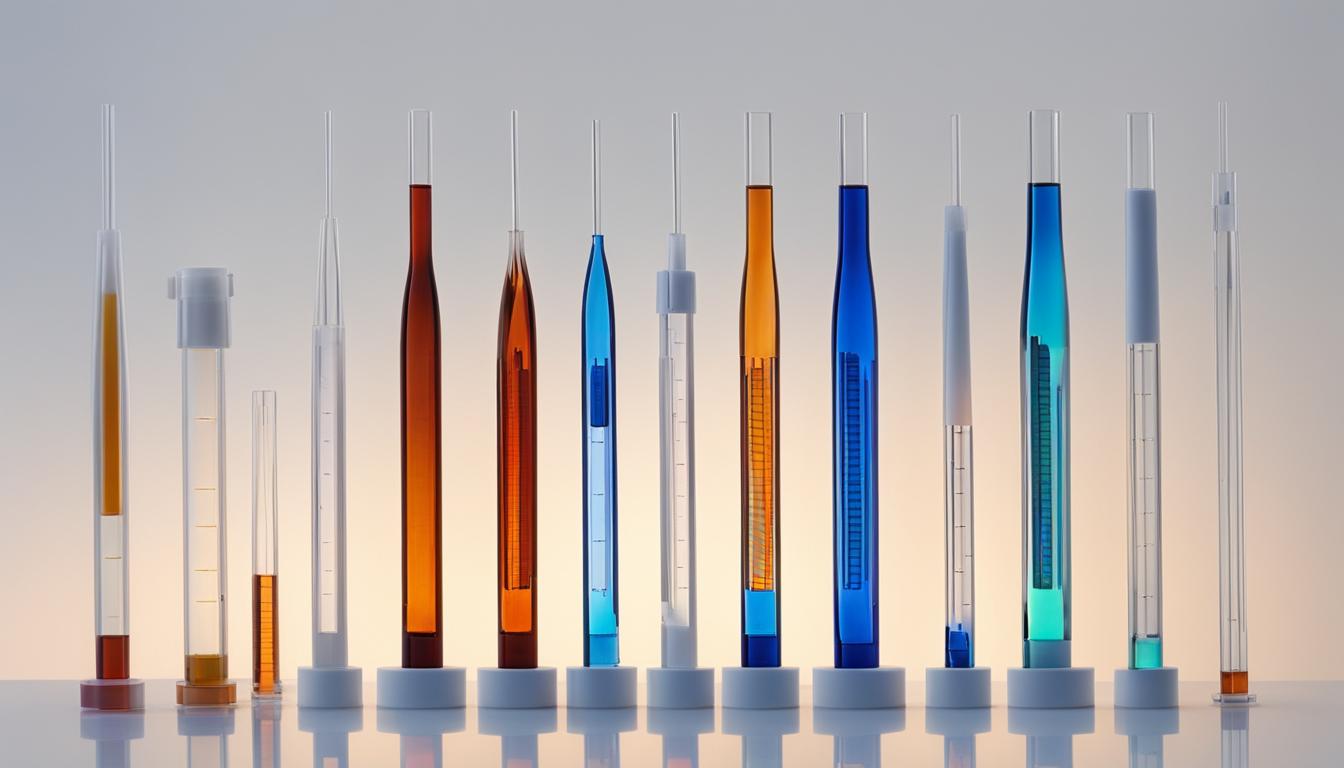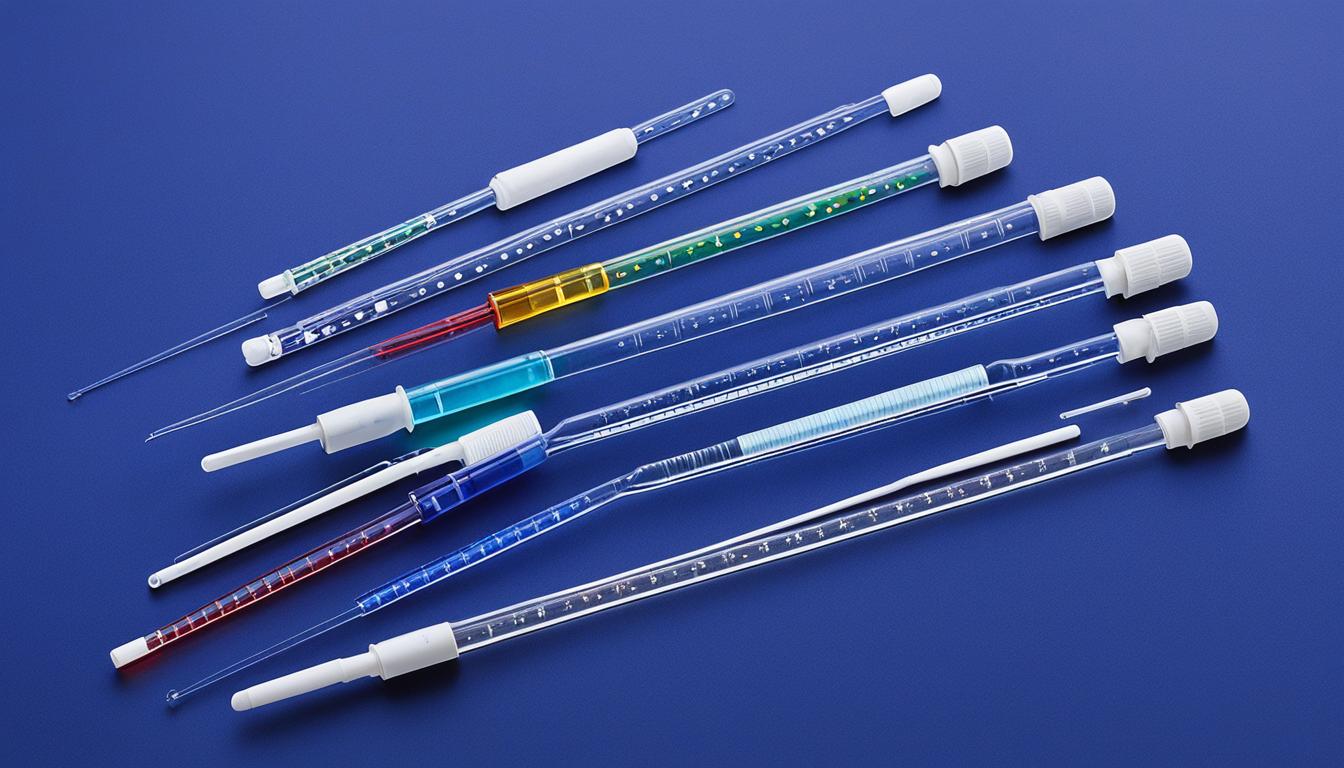Graduated, volumetric, and micro volume pipettes are essential for accurate liquid measurement in laboratories. Understanding their principles, parts, and procedures ensures effective use for varied scientific experiments.
Essential Pipette Types and Their Principles
Graduated Pipettes
Graduated pipettes are essential for precise measurements in labs. With multiple markings along their length, they let you measure different volumes of liquid accurately. These tools are perfect for quantitative tests where precision is key.
Available in various sizes and materials, graduated pipettes are versatile for different samples and tests. They’re especially useful for experiments requiring repeated measurements since you can quickly adjust to the needed volume.
Volumetric Pipettes
Volumetric pipettes excel at measuring a single volume of liquid with high accuracy. Unlike graduated pipettes, they feature a bulb that holds a specific amount when filled to the mark, making them ideal for exact measurements in quantitative tests.
These pipettes come in disposable or reusable forms and various sizes to handle different sample volumes. Single-channel volumetric pipettes are particularly useful in experiments demanding high precision and accuracy. Their design minimizes errors, ensuring reliable results in scientific research.
Micropipettes
Micropipettes are crucial in research labs for measuring very small volumes of liquid with great precision. These adjustable tools allow researchers to set the desired volume, making them versatile for many applications.
Micropipette tips play a significant role in ensuring accuracy and preventing contamination between samples. The ability to adjust the volume makes micropipettes suitable for a wide range of quantitative measurements in scientific research.
Each type of pipette offers unique advantages tailored to specific scientific needs. Whether it’s the flexibility of graduated pipettes, the precision of volumetric pipettes, or the versatility of micropipettes, choosing the right tool is vital for accurate experimental results.
Pipette Types for Specific Purposes
Micro Volume Pipettes
Micro volume pipettes are crucial in biotech and research labs. They offer high accuracy and precision, which is key when dealing with tiny liquid amounts. Often used in DNA sequencing or protein analysis, these pipettes ensure exact measurements. Their design minimizes sample loss, guaranteeing reliable results.
Multi-Channel Pipettes
Multi-channel pipettes excel in high-throughput tasks in molecular biology and diagnostics. These tools can dispense multiple samples simultaneously, making them perfect for PCR setups or ELISA assays. By speeding up sample preparation, they enhance efficiency and reduce the risk of cross-contamination.
Pasteur Pipettes
Pasteur pipettes are a staple in microbiology labs for transferring liquids. Used in procedures involving culture media or reagent transfers, they come in glass or plastic versions and can be disposable or reusable. Their simple design makes them versatile for various lab tasks.
Understanding the specific uses of these different types of pipettes helps you choose the right tool for your lab needs, ensuring both accuracy and efficiency in your scientific work.

Understanding Your Audience
Knowing who you’re talking to is key. When you get what your audience wants, you can create content that really hits home.
Research Your Topic
Dig into reliable sources before you start writing. This way, your content stays accurate and people can trust what you say.
Craft a Compelling Headline
A killer headline grabs attention and tells readers what to expect. Make it catchy but clear.
Write for Scannability
Break up your text with headings, subheadings, bullet points, and white space. It helps readers find what they need fast.
Use Visuals
Throw in some images, videos, or graphics. They break up the text and make complex ideas easier to understand.
Promote Your Content
Get your content out there on social media, email newsletters, and other platforms to reach more people.
Relevance and Accuracy
Stick to the topic and give accurate, up-to-date info. This keeps your credibility intact.
Clarity and Conciseness
Keep things simple. Avoid jargon and filler words. Short sentences are easier to read.
Depth and Comprehensiveness
Cover your topic thoroughly but keep it concise. Offer value without overwhelming the reader.
Authority and Credibility
Back up your claims with evidence from credible sources. This builds trust with your audience.
Objectivity and Neutrality
Stay unbiased. Present facts without personal opinions unless asked for by the topic.
Engagement and Interest
Make your content interesting and engaging. Use storytelling elements when it fits to keep readers hooked.
Verify Compliance with Google EEAT Guidelines
- Experience: Ensure the author knows their stuff.
- Expertise: Support claims with expert sources or data.
- Authoritativeness: Cite authoritative sources.
- Trustworthiness: Keep information accurate and reliable.
Verify Compliance with Google Helpful Content Guidelines
- Make sure the content addresses user needs directly.
- Offer practical improvement suggestions if needed.
Assess Content for Good Ranking Potential
- Optimize headings with keywords.
- Include meta descriptions.
- Use internal links where relevant.
Identify Potential for Featured Snippets
- Answer questions directly in the text.
- Use lists or tables for quick answers when appropriate.
By sticking to these guidelines, you’ll create high-quality, SEO-friendly content that meets both user needs and search engine criteria effectively.

Comparing Pipette Types and Selection Criteria
Single-Channel vs. Multi-Channel Pipettes
Choosing between single-channel and multi-channel pipettes depends on your lab’s needs.Single-Channel Pipettes:
- Ideal for tasks requiring high accuracy and precision.
- Perfect for transferring individual samples.
- Commonly used in research labs for PCR and ELISA.
Multi-Channel Pipettes:
- Boosts throughput by moving multiple samples at once.
- Handy for filling microplates and high-throughput screening.
- Saves time on repetitive tasks while maintaining accuracy.
Manual vs. Electronic Pipettes
Deciding between manual and electronic pipettes involves considering ergonomics, accuracy, and precision.Manual Pipettes:
- Operated by hand, offering a traditional way of handling liquids.
- Usually cheaper than electronic ones.
- Requires more physical effort, which can lead to user fatigue over time.
Electronic Pipettes:
- Better ergonomics, reducing strain during long use.
- Offers higher precision with automated volume settings.
- Often includes features like multi-dispensing modes and programmable protocols.
Fixed vs. Adjustable Volume Pipettes
Choosing between fixed volume and adjustable volume pipettes depends on the flexibility needed for your experiments.Fixed Volume Pipettes:
- Set to dispense a specific volume of liquid.
- Ensures high accuracy due to its fixed setting.
- Ideal for routine tasks where the same volume is needed repeatedly.
Adjustable Volume Pipettes:
- Allows setting different volumes as needed for various applications.
- Provides greater flexibility in experimental design.
- Slightly more complex but offers versatility for diverse lab tasks.

Pipette Maintenance and Troubleshooting
Proper pipette maintenance is key to getting accurate and precise lab results. Regular calibration, cleaning, and verification help keep your pipettes working well.
Pipette Calibration and Verification
Calibration and verification are vital for keeping pipettes accurate. Calibration ensures your pipettes dispense the right amount of liquid. Verification checks if the calibration is correct.
- Calibration Process:
- Perform regularly based on usage frequency.
- Use a balance to check the volume dispensed.
- Adjust settings as needed.
- Verification Steps:
- Compare dispensed volumes with standard measurements.
- Test under controlled conditions to ensure reliability.
Regular calibration and verification keep your lab results precise and reliable.
Pipette Cleaning and Sterilization
Cleaning and sterilizing pipettes prevent contamination, ensuring accurate measurements. Proper maintenance includes regular cleaning routines.
- Cleaning Procedures:
- Disassemble the pipette according to manufacturer instructions.
- Clean each part with mild detergent or alcohol.
- Rinse thoroughly with distilled water.
- Sterilization Methods:
- Autoclaving: Suitable for heat-resistant parts.
- UV Sterilization: Ideal for non-autoclavable components.
Regular cleaning and sterilization prevent contamination, ensuring precise results every time you use your pipettes.
By following these guidelines for calibration, verification, cleaning, and sterilization, you can keep your pipettes accurate, precise, and reliable in all your lab work.By selecting the appropriate pipette, scientists and researchers can increase the reliability of their data and ultimately contribute to the advancement of scientific knowledge.
Proper Pipette Usage
Getting accurate results in the lab hinges on using a pipette correctly. Here are some simple techniques to nail proper pipetting:
- Pre-Wet the Pipette Tip: Before drawing your sample, aspirate and dispense the liquid a few times to condition the tip.
- Correct Pipetting Angle: Hold the pipette straight up when drawing liquids and at a 45-degree angle when dispensing.
- Smooth Plunger Action: Press and release the plunger gently to avoid air bubbles.
- Consistent Speed: Maintain a steady pace while drawing and dispensing liquids for better accuracy.
Following these tips reduces errors and boosts your pipetting accuracy.
Pipette Care and Handling
Proper care of your pipettes keeps them accurate and extends their lifespan. Check out these best practices:
- Storage:
- Store pipettes upright using a stand to prevent contamination.
- Keep them in a clean, dry place away from direct sunlight.
- Handling:
- Use both hands when handling a pipette to avoid dropping it.
- Avoid touching the shaft or tip cone with your fingers to keep them clean.
- Troubleshooting Common Issues:
- Inconsistent volumes? Check for air bubbles in the tip or leaks in the seal.
- Regularly calibrate your pipettes according to manufacturer guidelines.
These steps help extend the life of your pipettes and maintain their performance.
Ergonomics and Posture
Good ergonomics while using a pipette can prevent repetitive strain injuries (RSIs). Here’s how:
- Posture: Sit upright with feet flat on the floor, keeping your back straight.
- Pipetting Height: Adjust your workbench so that your arm stays close to your body.
- Breaks: Take regular breaks to stretch and rest your hand muscles.
Ergonomic practices make you more comfortable and efficient at work.
Tips for Avoiding Pipetting Errors
Reducing errors during pipetting is crucial. Consider these additional tips:
- Use appropriate tips for each type of liquid (e.g., low-retention tips for thick liquids).
- Avoid touching the inside of containers with the pipette tip to prevent cross-contamination.
- Check tips for cracks or damage before use.
Incorporating these strategies into your routine ensures more precise results in your experiments.

